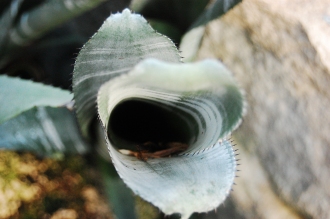Position: Indirect bright sun
Flowering period: All year round
Soil: Moist, well drained
Eventual Height: 60cm
Eventual Spread: 30cm
Hardiness: 10a, 10b, 11, 12, 13
Family: Bromeliaceae
Billbergia vittata is an evergreen tropical epiphytic perennial with an upright clump forming habit. Its dark green leaves have radial silver/ grey banding, are lanceolate with black spines along its margins, up to 30cm long and 5cm across. Its leaves are formed into a tubular shaped structure with a central cup or ‘tank. Its purple tipped white tubular flowers appear on a flower stalk which emerges from its ‘tank’ at the centre of the plant, within a significant pink/ purple bract structure. Its roots produce stolons which aids its slow spread and function primarily as anchorage. In addition new plants emerge from its stolons.
Billbergia vittata, commonly known as Banded Billbergia, is native to east Brazil. In its native habitat it grows as a tropical forest understory plant and on tree stems at an altadude of between 1,200m and 1,400m.
The etymological root of the binomial name Billbergia is named for J.G. Billberg (1772–1844), a Swedish botanist. Vittata is derived from the Latin vitta menaing ‘ribbon’, in reference to its striped leaves.
The landscape architect may find Billbergia vittata useful as an attractive foliage houseplant suitable for growing in pots. It may also be used as an effective ground cover plant in atrium type planting schemes. They also may be displayed as epiphytes growing in the forks of trees.
Ecologically, Billbergia vittata is of little value to UK wildlife.
Billbergia vittata prefers moist, humus rich, well-drained soils. It tolerates most pH of soil.
When maintaining Billbergia vittata as a houseplant its ‘tank’ should be watered regularly. Watering will need to be reduced during the winter months. It should be noted, this plant dislikes calcareous water. Its preferred active growing temperature rages from between 16ºc to 30ºc, although it will tolerate a temperature as low as near freezing for short periods. This plant may be sprayed with water to improve humidity.
![]()
Landscape Architecture












